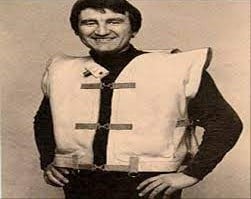It’s no coincidence that Protan was chosen to collaborate with, and provide roofing for, one of the world’s most innovative companies, Amazon.com. After all, innovation has been the watchword throughout the Protan story.
1939: Impregnated life jackets
It all started in 1939 with a resourceful shipbroker called Haakon Kierulf. He established Tønnevesten AS, a company that produced canvas life jackets impregnated with creamed rubber latex. The company's 10 employees made up to 40-50 life jackets per day.

1941: Impregnated blackout curtains
But when the war arrived and German warships wanted to use the life jackets produced by the little company in Drammen, Kierulf ceased production. He hatched a new business idea: The company began to impregnate blackout curtains instead Tønnevesten changed its name to A/S Spesialimpregnering, and the company impregnated both fabric and paper. But then the next challenge came along: Creamed rubber latex became a commodity in short supply during the war.
1942: Impregnation with kelp
The company conducted many experiments to find a substitute for rubber and the solution came from the ocean. The alginic acid found in kelp and other algae became the starting point for the next chapter in the company’s history, when it was found that a kelp solution could be used for impregnation.
The company subsequently became one of the world’s biggest producers of alginic acid, which is also found in soap, toothpaste and pectin.
In 1942 the alginic acid business was transferred to a new company called Protan. ‘Pro’ stood for products and ‘tan’ formed the first letters of the Norwegian word for kelp – tang.
1948: Rubber ventilation ducts
Protan’s products soon became a success. Norsk Hydro, one of Norway’s most influential industrial companies, then became an owner, and this gave the innovators at Protan the impetus to develop a new business idea for durable ventilation products. Shortly afterwards, the ventilation duct Ventiflex was launched. Far superior to ventilation ducts of the time, this product quickly became an international success.
1952: Plastic floor coverings
Floor coverings were Protan’s main products between 1952 and 1981. Floor coverings from Protan were popular because they were very durable. But the margins were small for this product, which, in turn, led to the initiation of a new innovation process at the end of the 1960s to find new business areas.
1970: Plastic roof membranes
Thus, the next idea was born: plastic roof membranes. Protan collaborated with Swiss company Sarna Kunststoff AG to obtain the license to produce their product Sarnafil. This subsequent 23-year-long partnership helped place Protan on the world map as a roofing supplier.
1980: PVC roof membranes
In the 1980s PVC roof membranes became more recognised and Protan started to focus heavily on these. Over the next decade Protan developed a range of roofing systems and products for exposed roofs, protected roofs and green roofs, and built up a strong position in northern Europe as a leading roof membrane company.
1990-2014: The growth of new business areas
Protan continued innovating new products in more PVC-based business areas. One of its areas of focus in recent years has been technical textiles. The company, in collaboration with heavyweights within the oil and aquaculture industries has developed niche products that meet specialised needs. Ventiflex has become an international market leader within the area of ventilation systems and, since the 2000s, Protan has also developed world-leading quality membranes for wet room and radon protection as well as expanding geographically into almost 20 markets.
Today Protan is northern Europe’s biggest producer of thermoplastic roof membrane (PVC). In addition, the company produces different types of PVC-coated textiles for a range of uses.
2015: Expanding into Wet Room Solutions
With a focus on innovation and market expansion, Protan acquired Litex, a leading manufacturer of waterproof bathroom boards. This strengthened Protan’s position in the Nordic market for wet room solutions, ensuring that customers could benefit from a complete, high-quality system for moisture protection. Litex was already known for its easy-to-install and durable solutions, making it a natural fit for Protan’s growing portfolio.
2017: Introducing Protan BlueProof® – A Game Changer for Stormwater Management
As climate challenges increased, so did the need for smarter water management solutions. Protan took a bold step by launching Protan BlueProof®, a stormwater management roofing system that allows controlled water retention directly on the roof surface. This innovation helps mitigate flooding risks in urban areas and reduces strain on municipal drainage systems—another example of how Protan applies its expertise in waterproofing to solve modern environmental challenges.
2019: Strengthening the Tunnel and Infrastructure Sector
With the acquisition of Multiplan in Turkey, Protan expanded its capabilities in tunnel, basement, and roofing membranes. Multiplan was a respected player in the Turkish market, specializing in high-quality PVC and TPO membranes for demanding infrastructure projects. This move strengthened Protan’s position in the Middle East and surrounding regions while also enhancing its global production and supply chain, ensuring greater flexibility and reach.
2023: New PVC Factory in Poznań, Poland
To meet the growing demand for PVC roofing and waterproofing membranes, Protan opened a state-of-the-art production facility in Poznań. Designed for efficiency and sustainability, the factory reinforced Protan’s position as one of Northern Europe’s leading manufacturers of thermoplastic roofing solutions. It also allowed Protan to serve its European markets faster while focusing on environmentally friendly production methods.
2024: Consolidating Membrane Manufacturing Across Three Countries
With continued growth and an expanding international presence, Protan streamlined production by consolidating membrane manufacturing across Turkey, Poland, and Norway. This strategic move optimized production, increased capacity, and improved efficiency, ensuring that Protan’s PVC and TPO membranes remain at the forefront of quality and innovation.


